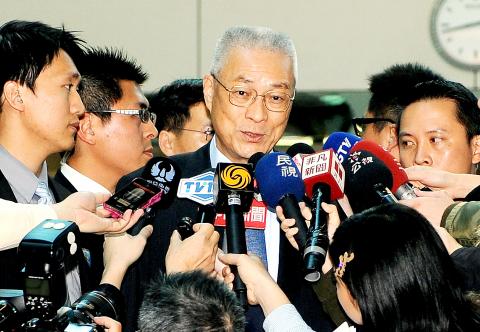Vice president-elect Wu Den-yih (吳敦義), in his meeting with Chinese Vice Premier Li Keqiang (李克強), should make clear that the term “one country” in the “one country, two areas” touted by the Chinese Nationalist Party (KMT) refers to the Republic of China (ROC), or the proposal is nothing but a fraud, Taiwan Solidarity Union (TSU) Chairman Huang Kun-huei (黃昆輝) said yesterday.
“Since President Ma Ying-jeou (馬英九) said that the term ‘one country’ in the ‘one country, two areas’ proposal refers to the ROC, Wu should clarify this directly with Li. He should also specify that the ‘two areas,’ the ‘mainland area’ and the ‘Taiwan area,’ both fall under the supervision of the ROC,” Huang said. “In addition, Wu should state that the ‘one China’ in ‘one China, different interpretations’ also refers to the ROC.”
Wu yesterday departed for the Boao Forum being held in China’s Hainan Island from today through Tuesday. Wu is attending the forum in his capacity as the top adviser to the Cross-Straits Common Market Foundation, rather than as vice president-elect, and is expected to meet Li at the forum today. Li is widely tipped to become China’s premier when the country undergoes a leadership transition later this year.

Photo: Chu Pei-hsiung, Taipei Times
Huang said that Ma only dared interpret “one country” and “one China” as the ROC in front of Taiwanese.
The “one country, two areas” formula former KMT chairman Wu Poh-hsiung (吳伯雄) touted during his meeting with Chinese President Hu Jintao (胡錦濤) on March 22 in Beijing would likely be interpreted by the international community as Taiwan’s official acceptance of the concept of “one China” as recognized by the majority of countries as meaning the People’s Republic of China (PRC), Huang said.
The rhetoric suggested that Ma had willingly degraded Taiwan into a “Taiwan area” special administrative region like Hong Kong, Huang said.
TSU caucus convener Hsu Chun-hsin (許忠信) said Wu Den-yih had failed to brief the public on the topics to be discussed when he meets China’s top officials at Boao. This highlights a lack of transparency and inequality between the two sides at the forum, which is detrimental to Taiwan, Hsu added.
Noting that Vice President Vincent Siew (蕭萬長) had also paid Hu a visit after Ma took office in 2008, Hsu, pointing to Wu Den-yih’s meetings with high-ranking Chinese officials through the Boao Forum, expressed further concerns.
“Such meetings could turn into a convention between the KMT and China. What if Wu Den-yih’s mission is to brief Chinese leaders of Taiwan’s four-year plans on cross-strait policies? Will Beijing also ‘give out instructions’ on the direction of cross-strait relations to Wu?” Hsu said, adding that such closed-door meetings would only bring harm to Taiwan.
Prior to his departure for China yesterday, Wu Den-yih reiterated that the “one country” referred to in the new formula is the ROC.
The “one China” mentioned in the so-called “1992 consensus” also refers to the ROC under Taiwan’s interpretation of the formula, he said, while China can define “one China” in any way it wants.
“Only by shelving differences can we jointly create a win-win situation,” he added.
Additional reporting by CNA
Translated by Stacy Hsu, Staff Writer

Authorities have detained three former Taiwan Semiconductor Manufacturing Co (TMSC, 台積電) employees on suspicion of compromising classified technology used in making 2-nanometer chips, the Taiwan High Prosecutors’ Office said yesterday. Prosecutors are holding a former TSMC engineer surnamed Chen (陳) and two recently sacked TSMC engineers, including one person surnamed Wu (吳) in detention with restricted communication, following an investigation launched on July 25, a statement said. The announcement came a day after Nikkei Asia reported on the technology theft in an exclusive story, saying TSMC had fired two workers for contravening data rules on advanced chipmaking technology. Two-nanometer wafers are the most

NEW GEAR: On top of the new Tien Kung IV air defense missiles, the military is expected to place orders for a new combat vehicle next year for delivery in 2028 Mass production of Tien Kung IV (Sky Bow IV) missiles is expected to start next year, with plans to order 122 pods, the Ministry of National Defense’s (MND) latest list of regulated military material showed. The document said that the armed forces would obtain 46 pods of the air defense missiles next year and 76 pods the year after that. The Tien Kung IV is designed to intercept cruise missiles and ballistic missiles to an altitude of 70km, compared with the 60km maximum altitude achieved by the Missile Segment Enhancement variant of PAC-3 systems. A defense source said yesterday that the number of

A bipartisan group of US representatives have introduced a draft US-Taiwan Defense Innovation Partnership bill, aimed at accelerating defense technology collaboration between Taiwan and the US in response to ongoing aggression by the Chinese Communist Party (CCP). The bill was introduced by US representatives Zach Nunn and Jill Tokuda, with US House Select Committee on the Chinese Communist Party Chairman John Moolenaar and US Representative Ashley Hinson joining as original cosponsors, a news release issued by Tokuda’s office on Thursday said. The draft bill “directs the US Department of Defense to work directly with Taiwan’s Ministry of National Defense through their respective

Tsunami waves were possible in three areas of Kamchatka in Russia’s Far East, the Russian Ministry for Emergency Services said yesterday after a magnitude 7.0 earthquake hit the nearby Kuril Islands. “The expected wave heights are low, but you must still move away from the shore,” the ministry said on the Telegram messaging app, after the latest seismic activity in the area. However, the Pacific Tsunami Warning System in Hawaii said there was no tsunami warning after the quake. The Russian tsunami alert was later canceled. Overnight, the Krasheninnikov volcano in Kamchatka erupted for the first time in 600 years, Russia’s RIA